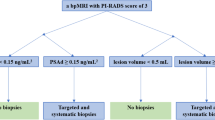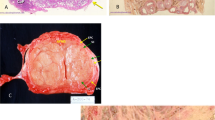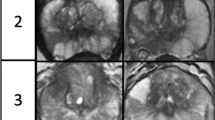Abstract
Purpose
To report the precision of a technique of measuring the PZ thickness on T2-weighted MRI and report normal parameters in patients with normal-sized prostates. We also wanted to establish the mean and second standard deviations (2SD) above and below the mean as criteria for abnormally narrow or expanded PZ thickness.
Methods
Of the initial 1566 consecutive cohort referred for evaluation for carcinoma based on elevated PSA (prostate specific antibody) or DRE (digital rectal examination), 132 separate subjects with normal-sized prostates were selected for this study. Mean age was 58.2 years (15–82). Median serum PSA was 6.2 ng/mL (range 0.3–145). Most were asymptomatic for lower urinary tract symptoms (LUTS). Inclusion criteria in this study required technically adequate T2-weighted MRI and total prostatic volume (TPV) ≤ 25 cc. Exclusion criteria included post-prostatic surgical and radiation patients, patients having had medical management or minimally invasive therapy for BPH, those being treated for prostatitis. Patients with suspected tumor expanding or obscuring measurement boundaries were also not considered. Transition zone (TZ) and peripheral zone (PZ) volumes were determined using the prolate ellipsoid model. Posterolateral measurement of the PZ was obtained at the axial level of maximal transverse diameter of the prostate on a line drawn from the outer boundary of the TZ to the inner boundary of the external prostatic capsule (EPC). The data were normally distributed. Therefore, it was analyzed using the 2-sided student t-test and Pearson product correlation statistic.
Results
Mean pooled (composite) measurement for the posterolateral PZ (PLPZ) was 10 mm (CI 9.5–10.5 mm) with SD of 2.87 mm. Means were statistically the same for the 2 observers (p = 0.75). Pearson correlation between the two observers was 0.63.
Conclusions
In a prostate ≤ 25 cc volume , the posterolateral PZ should be no thicker than 15.8 mm and averages 10.0 mm when measured in the maximal axial plane on MRI. These norms were independent of age or use of endorectal coil. The technique measurement demonstrated clinically useful precision.





Similar content being viewed by others
References
Wasserman NF (2006) Benign prostatic hyperplasia: a review and ultrasound classification. Radiol Clin N Am 44:689–710ß
Wasserman NF, Spilseth B, Golzerian J, Metzger BJ (2015) Use of MRI for lobar classification of benign prostatic hyperplasia: potential phenotypic biomarkers for research on treatment. AJR 205:564-571
Marks LS, Roehrborn CG, Wolford E, Wilson TH. (2007) The effect of Dutasteride on peripheral and transition zones of the prostate and value of the transition zone index in predicting treatment response. J Urol 177:1408-1413
Meikle AW, Stephenson RA, Lewis CM, Middleton RG. (1997) Effects of age and sex hormones on transition and peripheral zone volumes of prostate and benign prostatic hyperplasia in twins. J Clin Endocrinology and Metabolism 82:571-575
Turkbey B, Huang T, Vourganti S, Trivedi H, Bernardo M, et al (2012) Age-related changes in prostate zonal volumes as measured by high-resolution magnetic resonance imaging (MRI): a cross-sectional study in over 500 patients. BJUI 110:1642-1647
Matsugasumi T, Fujihara A, Ushijima S, Kanazawa M, Yamada Y, et al. (2017) Morphometric analysis of prostate zonal anatomy using magnetic resonance imaging: impact on age-related changes in patients in Japan and the USA. BJU international 120:497-504
Witjes WPI, Aarnink RG, Ezz-El-Din K, Wijkstra H, Debruyne FMJ, dl la Rosette JJMCH. (1997) The correlation between prostate volume, transition zone volume, transition zone index and clinical and urodynamic investigations in patients with lower urinary tract symptoms. BJU 80:84-90
Suzuki T, Kurokawa K, Takahashi O, Yajima H, Ito H, Yamanaka H. (1995) Changes in prostatic thickness and the location of ejaculatory ducts in autopsy prostates. BJU 75:647-650
Kwon JK, Han JH, Choi CH, Kang DH, Lee JY, Kim JH, et al. (2016) Clinical significance of peripheral zone thickness in men with lower urinary tract symptoms/benign prostatic hyperplasia. BJU International 117:316-322
Wasserman NF, Niendorf E, Spilseth B. Measurement of Prostate Volume with MRI (A Guide for the Perplexed): Biproximate Method with Analysis of Precision and Accuracy. Sci Rep 10, 575 (2020) https://doi.org/10.1038/s41598-019-57046-x
Barry MJ, Fowler FJ, O’Leary MP, Bruskewitz RC, Holtgrewe HL, Mebust WK, Crockett ATK. (2017) The American urological association symptom index for benign prostatic hyperplasia. J Urol 197 (2) suppl. S189–197
Kaplan SA, Te AE, Pressler LB, Olsson CA. (1995) Transition zone index as a method of assessing benign prostatic hyperplasia: correlation with symptoms, urine flow and detrusor pressure. J Urol 154:1764-1769
Güzelsoy M, Kirkali Z. (2016) Role of transition zone index in the prediction of clinical benign prostatic hyperplasia. J Urological Surg 4:114-118
El Ghoneimy M, Magdi M, Rassoul A, El Fayoumy H, Hakim AA. (2017) Significance and clinical value of transitional zone volume (TZV) or index (TZI) in assessing the degree of lower urinary tract obstruction: revisited. African Journal of Urology 23:9-13
Lepor H, Nieder A, Feser J, O’Connell C, Dixon C. (1997) Total prostate and transition zone volumes and transition zone index are poorly correlated with objective measures of clinical benign prostatic hyperplasia. J Urol 158:85-88
Taneike R, Kojima M, Saitoh M. Transrectal ultrasonic planimetry of the prostate in relation to age and lower urinary tract symptoms among elderly men in Japan. Tohoku J Exp. Med 1997:183:135-150
Zhang S-J, Qian H-N, Zhao Y, Sun K, Wang H-Q, Liang G-Q, et al. Relationship between age and prostate size. Asian J Andrology 2013:15:116-120
Choi J, Ikeguchi EF, Lee SW, Choi HY, Te AE, Kaplan SA. Is the higher prevalence of benign prostatic hyperplasia related to lower urinary tract symptoms in Korean men due to a high transition zone Index? European Urology 2002;42:7-11
Huang T, Qi J, Yu Y-J, Xu D, Jiao Y, Kang J et al. Transitional zone index and intravesical prostatic protrusion in benign prostatic hyperplasia patients: correlations according to treatment received and other clinical data. Korean J Urol 2012;53:253-257
Otani T, Fujimoto K, Yoshida K Ozoono S, Hirao Y, Okajima E, et al. Transition zone index in predicting therapeutic efficacy of benign prostatic hyperplasia. Japanese J Urol 2002;93:20–27
Guneyli S, Ward E, Peng Y, Yousuf AN, Trilisky I Westin C, Antic T, Oto A. MRI evaluation of benign prostatic hyperplasia: correlation with international prostate symptom score. J Magn Reson Imaging 2017;45:917–925
Jakobsen H, Tor-Pedersen S, Juul N. Ultrasonic evaluation of age-related human prostatic growth and development of benign prostatic hyperplasia. Scand J Urol Nephrol (suppl) 1998;107:26-31
Fujikawa S, Matsuura H, Kanai M, Fumino M, Ishii K, Arima K, et al. Natural history of human prostate gland: morphometric and histopathological analysis of Japanese men. The Prostate 2005;65:355-364
Author information
Authors and Affiliations
Corresponding author
Ethics declarations
Conflict of interest
The authors have no conflicts of interest to report.
Additional information
Publisher's Note
Springer Nature remains neutral with regard to jurisdictional claims in published maps and institutional affiliations.
Rights and permissions
About this article
Cite this article
Wasserman, N.F., Spilseth, B. & Sanghvi, T. Prostatic peripheral zone thickness: what is normal on magnetic resonance imaging?. Abdom Radiol 45, 4185–4193 (2020). https://doi.org/10.1007/s00261-020-02650-z
Received:
Revised:
Accepted:
Published:
Issue Date:
DOI: https://doi.org/10.1007/s00261-020-02650-z




